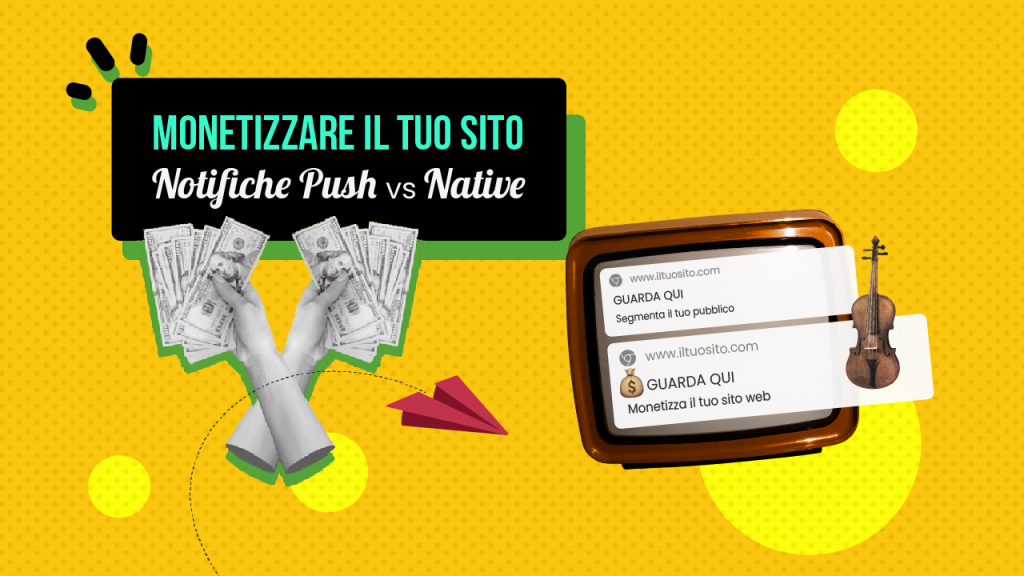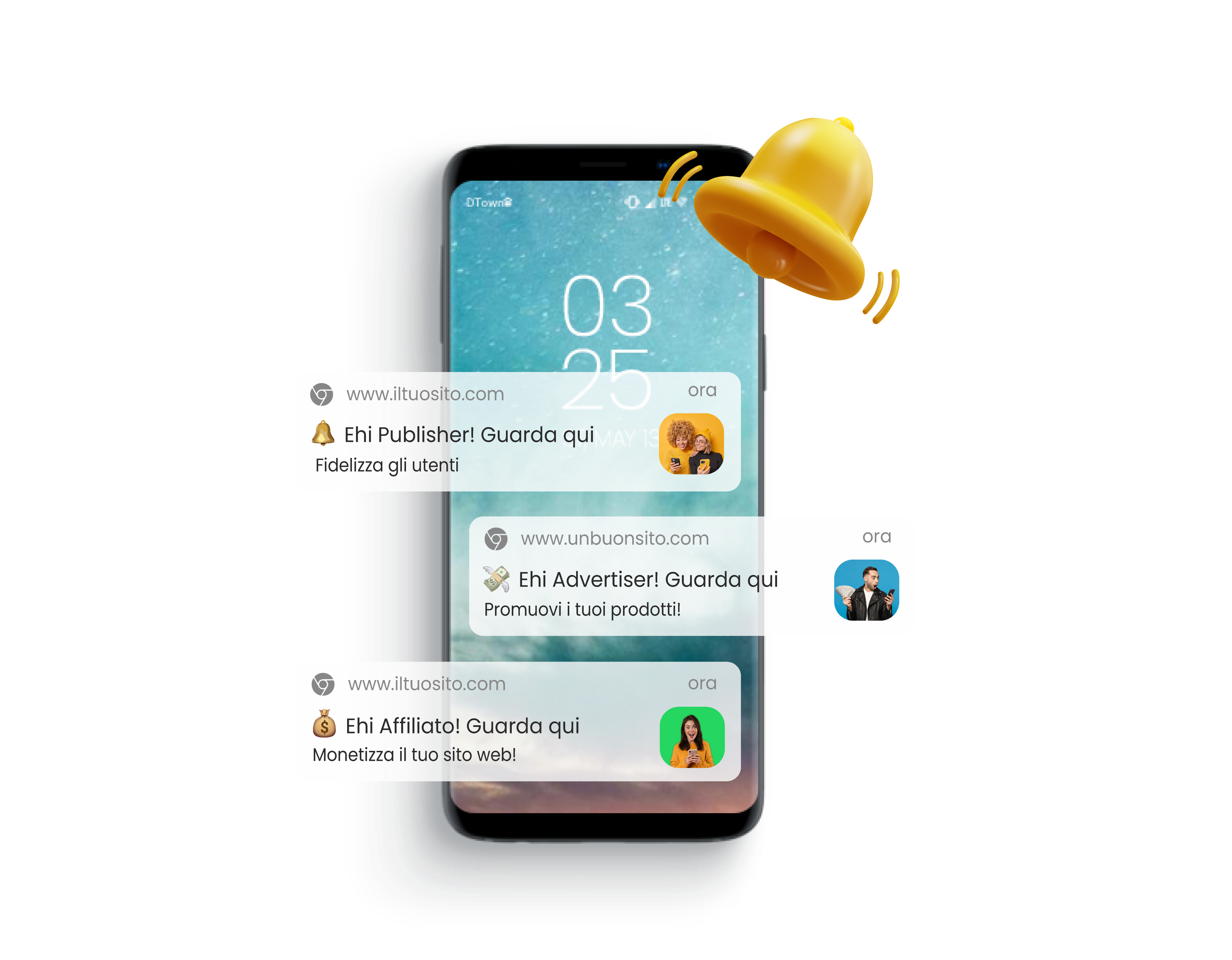
Monetizing one’s website or blog is a common goal among publishers of all sizes, from small personal platforms to large news outlets.
Traditionally, the most traveled path to achieve this includes the use of Google Adsense, banner ads and native advertising, methods that are effective but often pose challenges related to the user experience and aesthetics of the site itself.
While these forms of advertising can generate significant revenue, they can also make browsing less enjoyable, risking alienating readers.
Faced with this challenge, a promising and less invasive alternative emerges: push notifications.
In this article we will explore the various alternatives and what is the best strategy to monetize your website.
Traditional Monetization
Google Adsense and Native Ads: Advantages and Disadvantages
Google Adsense is one of the most popular tools for monetizing a website, due to its ease of implementation and ability to generate passive revenue based on user clicks.
On the other hand, native ads, advertisements that blend in with site content to appear less invasive, offer a more subtle approach to advertising.
Both methods have undeniable advantages, such as the ability to quickly initiate a monetization strategy and the ability to target ads relevant to audience interests.
However, there is no shortage of disadvantages. Google Adsense and native ads canreduce the visual quality of the site, overloading it with advertising content that distracts attention from the original content.
In addition, excessive ads can slow down page load times, worsening the user experience and potentially negatively affecting SEO ranking.
Impact on User Experience and Site Traffic.
Excessive use of banners and native ads can directly affect user experience and site traffic.
Invasive or irrelevant ads can irritate visitors, causing them to leave the site before they have interacted with the content or completed a desired action, such as signing up for a newsletter or making a purchase.
This behavior can lead to an increased bounce rate and reduced average time spent on the site, two key metrics that affect online visibility and the ability to attract qualified traffic.
In this scenario, it is critical for publishers to strike a balance between the need to monetize their online space and the desire to provide a positive and engaging user experience. The challenge lies in leveraging revenue opportunities without compromising the quality of the site and the satisfaction of its readers.
Push Notifications to monetize your site
What is a Push Notification? Brief Explanation
A push notification is a message that is sent directly to a user’s device (smartphone, tablet, or desktop) from the application or website to which the user has given consent to receive such communications.
Unlike emails or traditional advertisements, push notifications appear as small pop-ups on the device screen, offering information, promotions or updates in real time. This immediate visibility makes them an extremely effective communication tool to capture the user’s attention.
Benefits of Push Notifications for Monetization without Interrupting Reading
Push notifications offer numerous benefits for publishers seeking to monetize their site or blog without sacrificing the reading experience for their visitors.
Here are some of the key benefits:
- Increased Engagement: Due to their ability to reach the user directly, push notifications generate a significantly higher level of engagement than other communication channels. This translates into increased engagement and potentially more revenue through clicks on them.
- Non-Intrusiveness: Unlike advertisements that can take up valuable space on the site or interrupt browsing, push notifications are displayed unobtrusively, without disturbing reading. Users can close them more easily if not interested, maintaining a positive user experience.
- Increased Return Traffic: Implementing push notifications on your blog is not only for monetization, but also to alert users to new content or special offers. In this way, publishers can encourage repeat visits to the site, thereby increasing overall traffic and monetization opportunities.
Through the strategic use of push notifications, publishers have the opportunity to create an effective monetization stream that enhances user engagement and quality of experience on the site, without having to rely solely on more classic methods.
Integrate Push Notifications into Your Site
Pushloop: your ally for push notifications
Pushloop emerges as an ideal solution for publishers who wish to integrate push notifications into their website.
This user-friendly platform allows you to launch push notification campaigns with ease, offering a full suite of tools to personalize messages, segment audiences, and analyze campaign effectiveness in real time. With Pushloop, you can turn casual visitors into regular readers and significantly improve your site’s monetization, all while maintaining a smooth and enjoyable user experience.
Create a database of visitors to monetize and improve engagement
One of the main benefits of adopting push notifications through Pushloop is the ability to build a database of visitors who have consented to receive your communications.
This database becomes a valuable resource for any monetization strategy, allowing you to target users with relevant offers and content that interests them.
In addition, you can use push notifications to increase visitor engagement, inviting them to return to your site whenever you publish new articles or launch exclusive promotions.
This approach not only helps keep engagement levels high but also opens up new avenues for direct and indirect monetization of your website, making the visitor database a key component in your growth strategy.
The Balance Between Push Notifications and Native Ads
Benefits of an integrated approach
Adopting an integrated approach that combines push notifications and native ads offers numerous benefits to publishers who wish to effectively monetize their blogs without compromising the user experience.
This synergistic strategy maximizes advertising revenue by leveraging the discretion and effectiveness of native ads, along with the immediacy of push notifications.
This optimal mix not only increases the chances of conversion and user engagement but also ensures that the advertising content is perceived as less invasive and more natural within the browsing experience.
Strategies for maintaining a high level of engagement without overloading the site with advertising
To maintain a high level of engagement without overloading the site with advertisements, it is essential to follow some targeted strategies:
- Accurate audience segmentation: Use data collected through push notifications and interactions with native ads to segment your audience based on interests, browsing behaviors, and preferences. This allows you to further personalize advertising content and notifications, increasing relevance to the user and, consequently, engagement.
- Balancing content and ads: Ensure that the original content of your blog is always the star by integrating native ads in a way that harmonizes with the design and flow of your articles. Push notifications can be used to emphasize specific content or offers without interrupting reading.
- Continuous monitoring and optimization: Regularly analyze the performance of both native ads and push notifications to identify what works best with your audience. Experiment with the frequency and timing of notifications and adjust the visibility of native ads based on feedback and engagement metrics.
- Valuing User Consent: Maintain transparent communication with your visitors about the use of push notifications and native ads by valuing their consent and offering the ability to customize reception preferences. This ethical approach not only respects the user but also builds trust and loyalty to your site.
By adopting these strategies, publishers can create an environment in which advertising and content coexist in balance, improving both monetization and the overall user experience on the site.
Conclusions
The Pushloop Team

